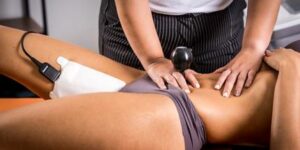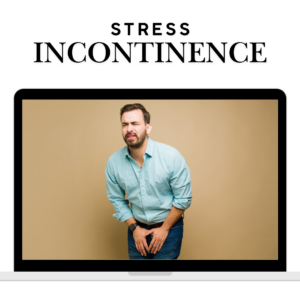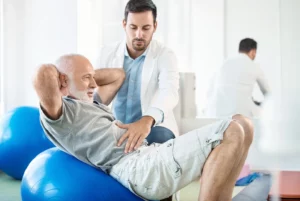Post Fall Syndrome or Psychomotor Regression Syndrome (PRS) is defined as:
“Decompensation of the systems and mechanisms implicated in postural and walking automatisms (Mourey, 2009)”
It appears either insidiously due to an increase of frailty or either brutally after a trauma (fall) or an operation. This syndrome is composed of a combination of neurological signs, motor symptoms and psychological disorder.
Motor symptoms
- Standing
- “Retropulsion” (gravity center kept backward)
- Posterior instability (tendency to fall backward)
- Both leading to postural compensation (Knees/hips kept flexed and bend forward) and to this traditional posture:
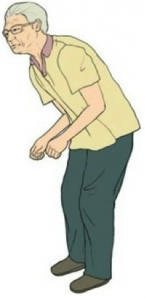
- Sitting
- Impairment of sitting posture is less visible but as problematic
- Patients with PRS keep their buttocks forward, shoulders backward and feet far from the seat (image B)
- However, to stand up we need to transfer our gravity center forward (image A)
- Therefore, standing up is difficult/impossible without exterior help for patients with PRS (image B)
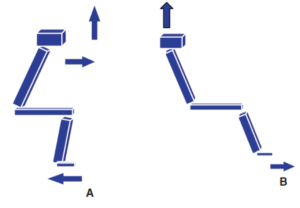
- Walking
- It is difficult for them to
- Initiate the walk (they look like freeze)
- Difficulty to avoid obstacle and to turn
- Gait
- ↓ length of the step
- ↓ knees and hips flexion (↑ trip risk)
- ↓ heel strike
- ↑ time spend in bipodal stance (↑ posterior instability)
- It is difficult for them to
Neurological signs
- Alteration or absence of postural adaptation (the person is not able to balance herself and to stand up without falling)
- Protective reaction (put her arms in front when falling to slow the fall)
Psychological disorder
- Patient with PRS present with
- Anxiety/phobia of verticality (afraid to stand up)
- Loss of self-confidence/self-esteem
- Loss of motivation associate with a reduction of their activity and social interaction
- Therefore, they end up in a vicious circle
- They are afraid to move
- They move less
- They become even less able to move and even more afraid
Treatment for patient suffering from Post fall syndrome is composed of:
- Exercise to promote movement and strength
- Postural work to correct the compensation
- Work on the change of position to teach the easy and safe way to stand up, sit down, and lie down.
- Work on the walk and to correct their gait
For more details please have a look at the Walking Rehabilitation section.

